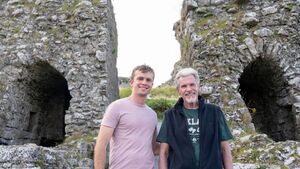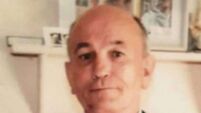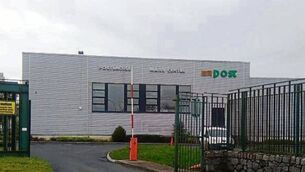American filmmaker puts the LA in Laois

Laois Nationalist, freelance writer John Davus, on set at The Rock of Dunamise, with film director John Gray Photos: Aisling Hyland
IN a recent article I wrote about the cultural significance of the Rock of Dunamase and how the iconic sight had a bright future ahead of it, while I certainly meant those words at the time of writing, I did not realise just how near that bright future was. In the weeks since that article was written, the Rock of Dunamase has been commandeered by American filmmaker John Gray as the setting of his new short film . Being a dedicated cinephile myself, I reached out to John in the hope of securing an interview.
Not only was Mr Gray kind enough to take the time from his busy schedule to speak with me, but his generosity also extended to a personal invitation to filming at the Rock of Dunamase. Suffice to say the experience was fascinating.
Born to Irish parents, John Gray hails from New York, where he built his reputation as a veteran filmmaker. Having spent years working with CBS, he is most widely recognised as the creator of the hit television phenomenon which ran for five seasons from 2005 to 2010.
In recent years, John has set himself the task of making one short film a year with his wife Melissa, working as a producer. His upcoming film is about a team of criminals fleeing a heist in Dublin, who regroup at the ruins of Dunamase castle, where a tale of treachery and betrayal unfolds. Having been privy to all the behind-the-scenes action, I can guarantee that The Stones of Dunamase Castle will be an enthralling thriller.
To begin our interview, I asked John about the film’s inception and how he came to choose the Rock of Dunamase as its setting. He replied with plain candour: “It just came from my love of crime thrillers – my love of mysteries and twists and turns and the ruins of Dunamase are such a fantastic metaphor for these characters’ lives. They’re all crumbling and falling apart just like this once great place where they now find themselves.” John went on to explain that another part of his reasoning to shoot the film here was due to the fact that he is moving to Ireland. “Once we knew we were moving here, my wife and I said, ‘well let’s make this one in Ireland.’ I knew I wanted a castle. I knew I wanted to be close to Dublin. So, from New York, I just started googling ‘castle ruins near Dublin’ and, of course, Dunamase came up and it just had such an interesting structure and feel to it. And, of course, the history of it is just so amazing.” John took great pride in noting that he had assembled an all-Irish crew for this project and spoke of them with the highest regard. While on set, I spoke with line producer Hugh Connell from Co Cork, who was entirely accommodating and made me feel most welcome. The same can be said for the entire cast and crew, who all took time to introduce themselves and make sure I felt included in the process.
One of the lead actors is Love/Hate’s Aoibhinn McGinnity, who I had the great pleasure of watching perform. While I won’t spoil anything here, I do feel quite smug knowing her character’s outcome and ultimate fate.
As we discussed his career in Hollywood, John explained that he has now “moved away from the Hollywood business,” having directed over 20 films and a couple dozen episodes of television. He confessed: “I’m still addicted to making movies and telling stories, but I don’t want to work with studios anymore. The best thing about producing our own short films is we don’t have to play ‘mother-may-I?’ with anybody. We cast them how we want and shoot them how we want.” As we delved deeper into the secrets of filmmaking, John revealed to me the challenges facing him as a director today. “Post-covid, it’s difficult to figure out what audiences actually want. The kind of movies that I like to make are really character-driven and those are not always the easiest movies to finance.” He continued: “Of course, nowadays, I don’t get to use the tools that I could when I was in my big filmmaking career but that’s okay. It’s still about the storytelling, the camera work and that teaches you how to be more creative.” When he’s not directing short films, John spends his time hosting filmmaking seminars where he gives classes on writing, directing and pitching, hoping to inspire the next generation of young filmmakers. He has also written two novels which he hopes to one day adapt to the screen.
On teaching his craft, I asked John what his best advice for aspiring creatives would be. His one definite prescription was the book Screenplay by Syd Field. “I read that book 30 years ago maybe, and it completely changed my life and how I write. I definitely recommend that. What’s great about writing is all you need is your keyboard and your brain and then there’s no limit to what you can do.” As our conversation drew to an end, we came to discuss John’s Irish heritage and how it has shaped his identity. Immensely proud of his ancestry, John shared with me the story of his great-grandfather’s emigration to America from the Emerald Isle. Recalling his Irish upbringing in America, he expressed his love of Irish music, particularly the Clancy Brothers and The Dubliners.
As a final question, I asked John what it meant to him being Irish. His answer was one of a most profound nature and quite frankly beautiful. “To me, it’s about the poetry of being Irish. The skill at writing. The skill at storytelling. What I love about the poetry that resonates in the heart and soul of the Irish is the fact that it extends to the beautiful and to the tragic. Finally, there’s the incredible strength when you think of what the Irish nation has survived. It’s so compelling and stirring.” Immensely moved by these words, it became abundantly clear to me that the spirit of the poet is certainly alive in John Gray.
As captivating as it was to listen to John discuss his creative process, it was all the more enchanting to watch the director in action on set. His talent as a filmmaker was on full display and could not be disputed. It was obvious that he had a clear vision for his project and knew how to achieve it. Not only that, John’s engaging manner with all the cast and crew as well as the inviting atmosphere fostered on set was commendable. My experience with John Gray was nothing short of a privilege.
is expected to tour film festivals in the new year and, who knows, perhaps the Dunamaise Arts Centre in Portlaoise will be honoured with a special screening.





